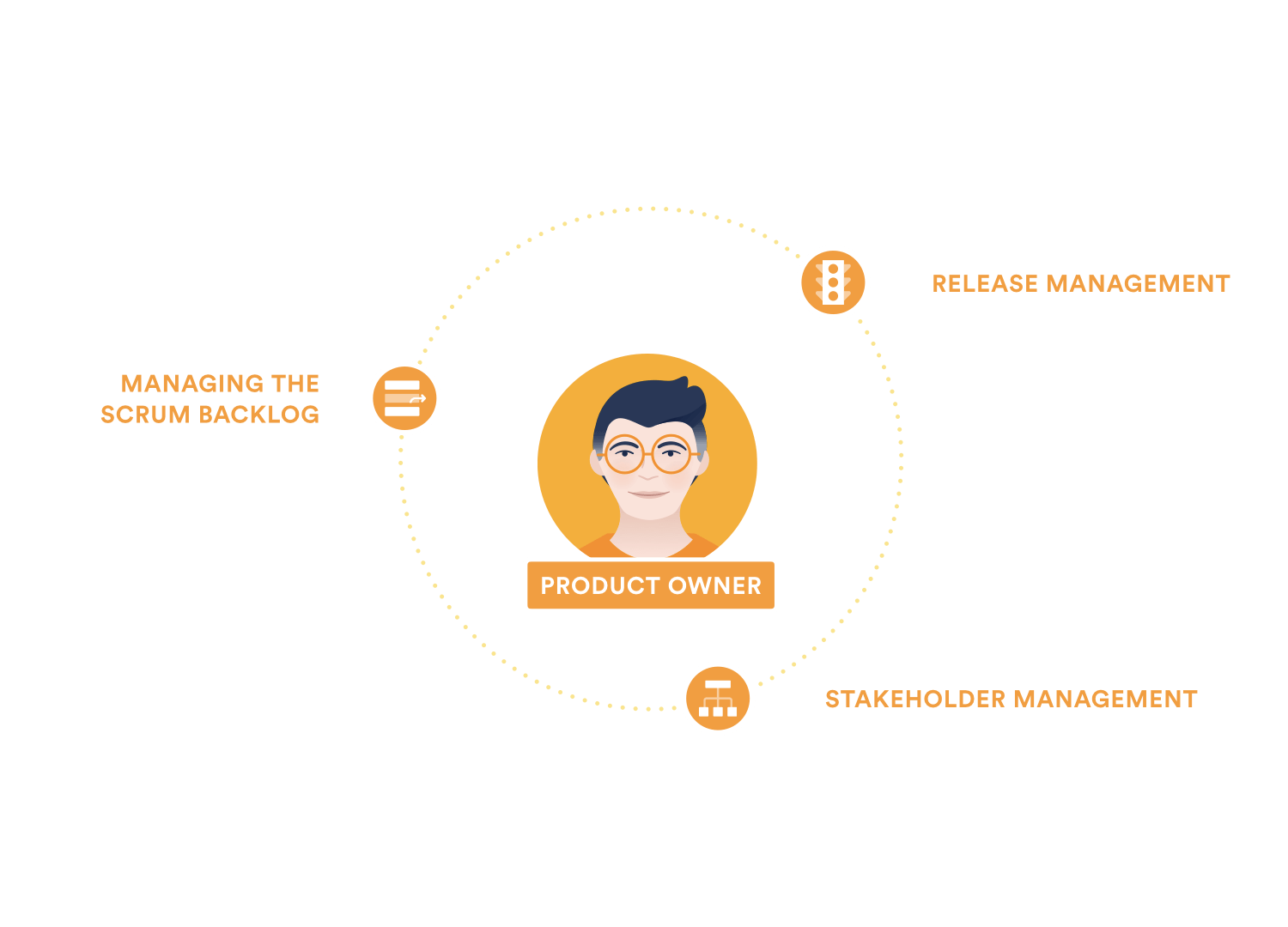Regularly in an agile software development project, the duties of a scrum master typically involve:
The Truth about Scrum Job Titles and Scrum Roles
Learn why the three scrum positions (scrum master, product owner, and development team) are more like job titles than job descriptions.
What are the 3 Scrum Roles?
Product owner, scrum master, and development team members are the three positions in Scrum. While this is fairly obvious, determining what to do with current job titles might be perplexing. When implementing scrum, many teams wonder if they need to modify their titles. No, is the quick response.
We’ll explain scrum roles and show you how to incorporate them into your company without having to create new business cards in this post.
Scrum Roles vs. Job Titles
The three scrum roles define the primary tasks of scrum team members. They aren’t jobbing titles in the traditional sense. This means that any job title, including your current one, is capable of fulfilling one of the tasks. The three roles provide a basic description of duties and responsibility to allow teams to effectively deliver work because the basis of scrum is empiricism, self-organization, and continual improvement. This helps teams to take ownership of how they structure themselves and to continue to improve.
Building a Scrum Team
Scrum is a foundation on which teams may construct their procedures. It establishes the foundation for regular meetings, artifacts, and who is responsible for what.
It does not, however, offer a one-size-fits-all blueprint for teams to follow. If the team is working on an online insurance application, for example, they will require experts who are familiar with the technology, back-end systems, and business domain. On the other hand, if the team is working on the next Donkey Kong, the talents required will be vastly different. A graphic designer, sound engineer, and graphics developer would be among them. Because the challenges are unique, so are the team structures and talents required.
The more complicated the problem a team is attempting to solve, the more difficult this becomes. “You don’t know what you don’t know until you know you don’t know,” as the adage goes. Teams may not know what talents or how much work they’ll need right away, and they’ll need the flexibility to change course once they do.
Scrum provides a lightweight structure with the three scrum roles of a development team member, product owner, and scrum master to provide some structure to this complicated, ever-changing, and often unpleasant environment.
Redefining the term “developer” by the development team
The people who do the job make up the development team. At first look, the phrase “development team” may conjure up images of engineers. However, this isn’t always the case. According to the Scrum Guide, the development team might include designers, authors, programmers, and other professionals.
Consider it in the same manner that you would employ a developer for a home improvement project. They plan the project and carry it out. Yes, this may imply that they lay bricks, install plumbing, or even dig holes, but the individual is referred to as a developer. As a result, the ‘developer’ job in scrum refers to a team member with the necessary expertise who works as part of the team to complete the task.

Scrum myth: Scrum developer implies that a scrum team may only consist of coders
The development team should be able to self-organize and make choices to complete tasks. Consider a development team to be analogous to a production support crew that is called in late at night to fix a problem. Like the production support team, the development team may make decisions and offer the fix/value for the problem at hand. Self-organization isn’t about dismissing the organization; rather, it’s about enabling the people closest to the problem to address it.
The development team’s responsibilities include:
- Getting the job done during the sprint.
- They gather every day during the daily scrum to guarantee openness throughout the sprint ( sometimes called a standup). The daily scrum ensures that the work is transparent, and it gives a dedicated space for team members to seek assistance, celebrate successes, and identify difficulties and roadblocks. The daily scrum may be facilitated by the scrum master, but the development team is ultimately responsible for running the meeting. It is their gathering to assist them in inspecting and adapting their work as a group and working more effectively.
The product owner is in charge of establishing a clear path
Agile teams are flexible and responsive by design, and the product owner must ensure that they are producing the maximum value. The product owner represents the company and informs development on what is most essential to providing. The importance of trust between these two jobs cannot be overstated.
Not only should the product owner understand the customer, but he or she should also have a vision for the value that the scrum team is providing to the client. The product owner also considers the demands of the organization’s other stakeholders.
As a result, the product owner must prioritize the work based on all of these inputs. This is probably their most critical role because competing priorities and unclear instructions will not only limit the team’s performance but will also damage the development team’s vital trust connection with the company.
Agile teams are built to analyze and adapt to changing circumstances. That implies a shift in priorities might result in significant changes to the team structure, work outputs, and ultimate results. As a result, it’s important for scrum teams to succeed and for just one individual to determine priorities. The product owner is the person who is in charge of the product.
The product owner’s responsibilities are defined in the Scrum Guide as follows:
- Managing the scrum backlog – This does not imply that they are the only ones that add new product backlog items. However, they are ultimately in charge of the backlog from which the development team works. That implies the product owner should be aware of everything in the backlog, and anybody adding things to the backlog should make sure they interact with the product owner.
- Release Management – The sprint is a planning cycle rather than a release cycle. Scrum teams may therefore deliver at any moment. They should deliver often throughout the sprint, allowing the sprint review to look at genuine customer feedback and use. However, continuous delivery is not always achievable, necessitating the use of other release models. Knowing when things may and should be released is critical for the product owner.
- Stakeholder Management – Users, customers, governance, and organizational leadership are all involved in the development of any product. To properly guarantee that the development team is generating value, the product owner will need to work with all of this personnel. Stakeholder management and communication may be required in this case.

The scrum master is in charge of keeping everything in order
The scrum master is in charge of tying everything together and ensuring that scrum is carried out properly. In practice, this means they assist the product owner in defining value, the development team in delivering value, and the scrum team in improving. The scrum master is a servant leader, which characterizes not just a helpful leadership style but also what they do daily.
They assist the product owner by assisting them in better understanding and communicating value, managing the backlog, planning and breaking down work with the team, and delivering the most effective learning. The scrum master helps the development team self-organize, focus on outcomes, get to a “done increment,” and handle roadblocks. The scrum master also assists the organization as a whole, assisting them in the understanding scrum and creating a scrum-friendly workplace.

The scrum master focuses on the following:
- Transparency – The relevant individuals must observe what’s going on to examine and adjust successfully. However, this is far more difficult than it appears. The scrum master is in charge of ensuring that the scrum team operates openly and transparently. Making narrative maps and updating Confluence pages with retrospective thoughts are two examples.
- Empiricism – The concept that the best way to plan is to perform work and learn from it is a cornerstone for scrum and agile techniques. The empirical method is difficult, and it necessitates the scrum master to coach the scrum team on how to break down work, provide specific outcomes, and evaluate those outputs.
- Self-organization – A development team’s ability to self-organize is not a guarantee that the team will do so. Self-organization, in reality, takes time and requires assistance and support. The scrum master will push team members to branch out and try new things, as well as employ techniques like ‘delegation poker‘ to reveal and question preconceptions about role boundaries and responsibilities.
- Values – The 5 values of courage, focus, commitment, respect, and openness are defined by Scrum not because they are pleasant to have, but because they create a physiologically secure and trusting atmosphere. Agility can only thrive in this kind of atmosphere. Everyone in the scrum team is responsible for adhering to the principles, but the scrum master plays a key role in promoting and reminding everyone of their significance.
In sprint planning and sprint reviews, the scrum master assists the product owner in ensuring that value is explicitly stated and direction is established. They assist the development team in the daily scrum by ensuring that work gets done and that roadblocks are removed. They also assume accountability for blocks that the team is unable to resolve. The scrum master makes sure that every opportunity for improvement is communicated to the scrum team, and that the retrospective has a clear set of actionable results.
Begin with Agile Scrum Roles
The three scrum jobs are quite straightforward in characterizing the three key areas of responsibility on any scrum team, but mapping them to your job description can be difficult. So here’s something to get you started:
- You should join the scrum development team if you have a lot of fantastic abilities for producing client value and that excites you. The team is the most crucial component of any agile business since it is the team that delivers value to customers and stakeholders. That is, seniority is decided by how much you add value or assist others in doing so.
- The product owner job is most matched to your aspirations if you are enthusiastic about the client, managing stakeholders, and the business domain. In most firms, this individual must have the business’s respect and confidence to make choices. As you negotiate trade-offs and keep everyone pleased, the position also needs some politicking.
- The scrum master position is for you if you want to help teams work efficiently together while simultaneously changing the world with scrum and agile; it’s a very people-centric role with a significant emphasis on coaching, training, and facilitation.
Here at CourseMonster, we know how hard it may be to find the right time and funds for training. We provide effective training programs that enable you to select the training option that best meets the demands of your company.
For more information, please get in touch with one of our course advisers today or contact us at training@coursemonster.com

